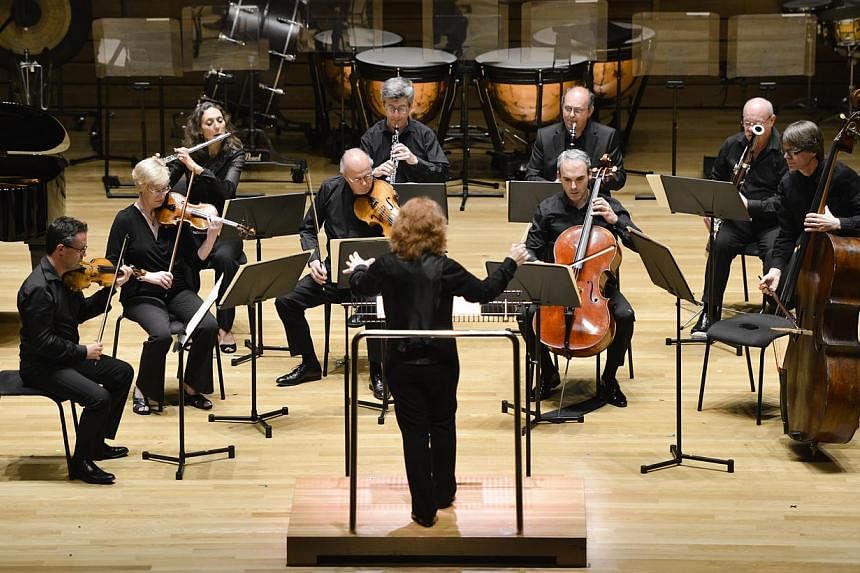By Southbank Centre, London Sinfonietta and the Yong Siew Toh Conservatory Orchestra
SOTA Concert Hall
September 5-7
Day two of mini-festival Listen To The 20th Century presented by the London Sinfonietta and Southbank Centre London featured two Russian works from 1936 to 1937, when Russia was under the Soviet Union, the Stalinist regime which was also nicknamed "the reign of terror".
Instead of the usual narration, this version of Peter And The Wolf was presented alongside a short, non-vocal film by Susie Templeton which won numerous awards, including an Oscar in 2008. Based in cold, wintry Russia, the film effectively complemented the music to bring the story to life. Like the earlier Schoenberg pieces for orchestra of day 1, this was also reduced for an ensemble of 13. The buoyant character of music and lighthearted moments in the film had also made it easy for the larger number of younger audience to appreciate. In the film, the wolf had looked like a harmless, badly taxidermied creature, but the trio of horn, clarinet and bassoon gave it a menacing character.
In the second half, the combined orchestra which played Shostakovich's Fifth Symphony filled the entire stage, and at louder moments, the orchestra seemed too large for the concert hall. Despite the sheer number of musicians, the best parts of the music were in the second movement when the orchestration was smaller and written for chamber-playing. There were numerous beautiful solos from the concert mistress and woodwinds. In the first and third movements, the strings, especially the violins, lacked warmth of tone, sounding shrill and almost astringent, but this characteristic proved effective in the final movement.
Day three saw a "marathon-concert" of three parts which started at 6pm and ended 41/2 hours later with two short intermissions. Works presented encompassed the avant-garde, the spiritual, and the minimalist. The first part opened with a recording of Karlheinz Stockhausen's Gesang der Jünglinge, for boy soprano and electronic tones, digitally synthesised and broadcast through speakers placed all around the hall for a surround-sound effect. The lights were turned off as well, inviting the audience to experience the music without the visual aspect of a performance. Victoria Simmonds came back on stage to sing Berio's 11 folk songs. Simmonds switched effortlessly between the different languages in the set, and was accompanied more than ably by John Constable on the piano. Before this, Constable turned the piano into a percussion instrument with bell-like sonorities by inserting bolts and screws into the body of the piano as instructed by John Cage, and proceeded to play five short works from his Sonatas and Interludes.
The second and third parts focused on the spiritual and meditative compositions which eventually led to minimalism. Steve Reich used motifs from the prosody of speech, transcribed them into musical motifs, and juxtaposed the two together on top of a recorded track in Different Trains. A live string quartet played the work alongside the recorded track with machine-like precision, replicating the monotonous grind of travelling trains and sirens in concentration camps. Arvo Pärt's meditative Fratres fared less well, and was marred by numerous intonation issues. Violinists Laurent Quenelle and Joan Atherton, who played in the quartets earlier, worked tirelessly as soloists for Schnittke's parody-laced Concerto Grosso no. 1, joined by Constable on the harpsichord and some students from the Yong Siew Toh Conservatory Orchestra.
Terry Riley's founding work of minimalism In C, written for any amount of instruments and any length of time, was given a late-night performance at 10pm by an eclectic mix of instruments: joining 13 orchestral instruments was an erhu, an accordion, and a yang qin. They created an ebb and flow around a constant tolling note C from a xylophone, sometimes letting the ethnic instruments take centre stage.
The two works before the intermission on the last day were by Asian composers Unsuk Chin and Toru Takemitsu. Chin's 2009 composition Gougalon was percussion-heavy, and required the other members of the chamber ensemble to hold and play a percussion instrument other than their own. In spite of this, the two percussionists were still kept in a frenzy, moving from instrument to instrument trying to play their parts. The musicians employed extended techniques in playing their instruments, bringing across the vivid and extravagant use of colours and messy textures. In stark contrast, Takemitsu's Rain Coming was a fluid, impressionistic soundscape, slightly reminiscent of Debussy, yet with more futuristic harmonies and shrouded in ambiguity.
A long-drawn unison C from the combined orchestra,the final note of Scottish composer James Macmillan's The Confession of Isobel Gowdie restored order to the last concert with No More Rules and brought the festival to an end. In British composer Thomas Adès' Chamber Symphony before, fragments of jazz and tonal motifs were sprinkled amidst the atonal, interconnected four movements.
Throughout the four days, every one of the musicians in the Sinfonietta had shown themselves to be top-notch performers in their field of new music, each having the dedication to learn, and the sensibility and sensitivity to listen, appreciate and interpret the music they were playing.
Although numerous significant composers such as Olivier Messiaen, George Crumb and Milton Babbitt had been left out, this mini festival has been a milestone in the introduction and performance of 20th century music in Singapore with numerous Singapore premieres.
After six concerts and five talks over four days by one of the world's leading contemporary classical music ensembles, hopefully the audience who journeyed through this sonic treasure hunt of sounds were challenged and found new aural experiences and enlightenment.

